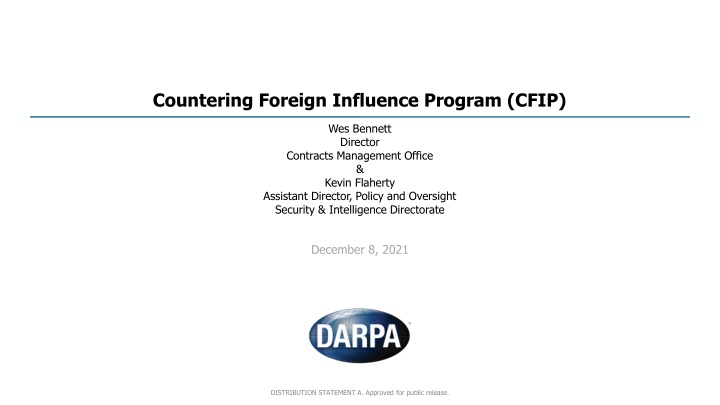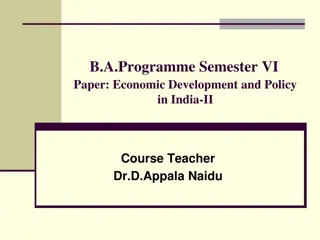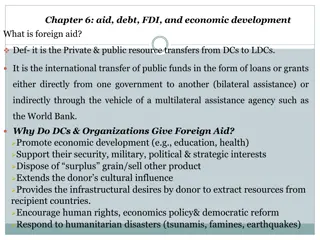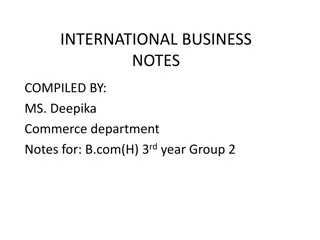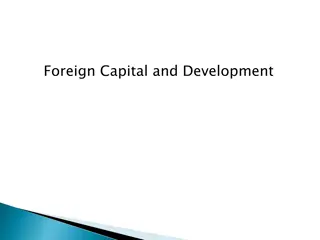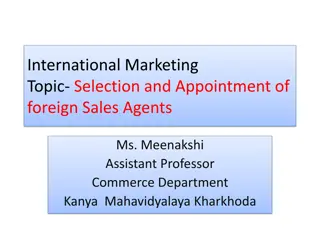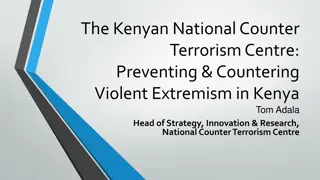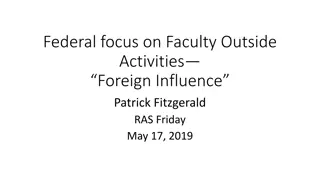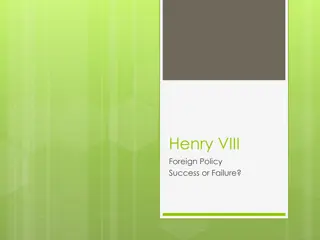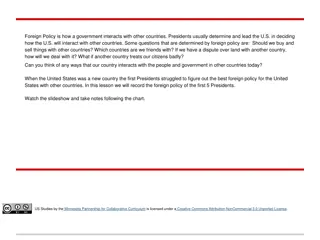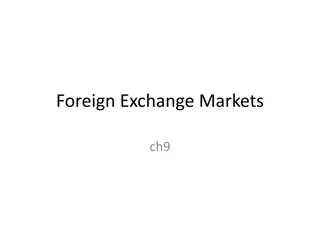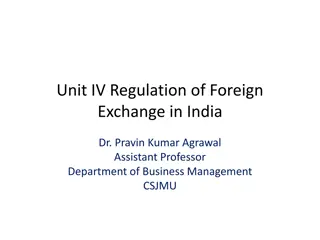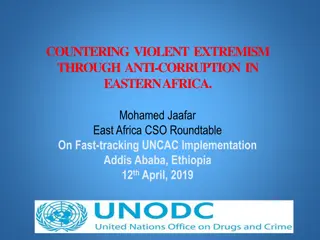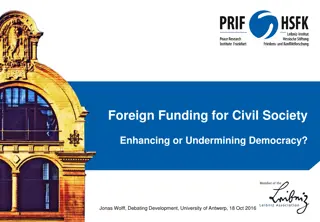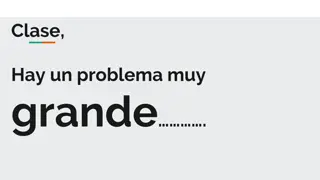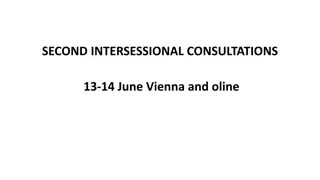Countering Foreign Influence Program Overview
CFIP is a security program addressing undue foreign influence in research funding. It involves risk assessment for key personnel to protect national security interests from exploitation by foreign entities.
Download Presentation

Please find below an Image/Link to download the presentation.
The content on the website is provided AS IS for your information and personal use only. It may not be sold, licensed, or shared on other websites without obtaining consent from the author.If you encounter any issues during the download, it is possible that the publisher has removed the file from their server.
You are allowed to download the files provided on this website for personal or commercial use, subject to the condition that they are used lawfully. All files are the property of their respective owners.
The content on the website is provided AS IS for your information and personal use only. It may not be sold, licensed, or shared on other websites without obtaining consent from the author.
E N D
Presentation Transcript
Countering Foreign Influence Program (CFIP) Wes Bennett Director Contracts Management Office & Kevin Flaherty Assistant Director, Policy and Oversight Security & Intelligence Directorate December 8, 2021 DISTRIBUTION STATEMENT A. Approved for public release.
Outline Background CFIP Overview and Applicability Foreign Influence Review Broad Agency Announcement Solicitation Process Negotiation/Mitigation Post-award Requirements DISTRIBUTION STATEMENT A. Approved for public release. 2
Background FY19 National Defense Authorization Act (NDAA) Section 1286 Initiative to Support Protection of National Security Academic Researchers from Undue Influence and Other Security Threats March 2019 USD(R&E) Memo Actions for the Protection of lntellectual Property, Controlled Information, Key Personnel and Critical Technologies Directs the use of SF-424 to collect information on key personnel Limit undue influence, including foreign talent programs by countries that desire to exploit United States technology within the DoD research, science and technology, and innovation enterprise. FY21 NDAA Sec. 223 Disclosure of funding sources in applications for federal research and development awards. Sec. 1062 Limitation on Provisions of Funds to Institutions of Higher Education Hosting Confucius Institutes Sec. 1299C/1286 Modification to the Initiative to Support Protection of National Security Academic Researchers from Undue Foreign Influence and other Security Threats . Sec. 1260H Public Reporting of Chinese Military Companies Operating in the U.S. Jan 21 NSPM-33 Supported Research and Development National Security Policy Unfortunately, some foreign governments, including the People s Republic of China, have not demonstrated a reciprocal dedication to open scientific exchange, and seek to exploit open United States and international research environments to circumvent the costs and risks of conducting research, thereby increasing their economic and military competitiveness at the expense of the United States, its allies, and its partners. While maintaining an open environment to foster research discoveries and innovation that benefit our Nation and the world, the United States will also take steps to protect intellectual capital, discourage research misappropriation, and ensure responsible management of United States taxpayer dollars. This includes steps to ensure that participants with significant influence on the United States R&D enterprise fully disclose information that can reveal potential conflicts of interest and conflicts of commitment . Academic Policies within academia and their associations (2019-Present) regarding foreign influence risks and best practices. DISTRIBUTION STATEMENT A. Approved for public release. 3
CFIP Overview and Applicability DARPA Director-signed CFIP Policy Memorandum, dated September 17, 2021 Requires undue foreign influence risk assessment of all proposed senior/key personnel selected for negotiation of a fundamental research grant or cooperative agreement award This policy may be integrated into a stand-alone guide or incorporated into an existing DARPA instruction CFIP is a security program that identifies potential undue foreign influence risk factors involving conflict of commitment (CoC) or conflict of interest (CoI) Informed by other Federal Programs as well as the USD(R&E) S&T Protection Working Group activities Utilizes volunteered (SF-424) and publicly-available information to assess risk Focus is on pre-award vs post award; DARPA s CFIP team does not launch investigations Assigns risk ratings of LOW to VERY HIGH (risk rubric) for proposing individuals deemed selectable Informs DARPA Program Managers, Office Directors, Scientific Review Officials, and DARPA Deputy Director (When applicable) Does not restrict or deny research Provides sponsoring institutions the opportunity to address and mitigate potential CoI / CoC risk factors. The CFIP Team Comprised of two MSO-SID analysts, exploring innovation/automation tools to help in the review process, support risk mitigation reviews CFIP has 4 Main Parts DARPA CFIP Policy , Broad Area Announcement Language, the CFIP Rubric, and the assessment Transparency is the foundation of the policy and process. DISTRIBUTION STATEMENT A. Approved for public release. 4
DARPA CFIP Rubric Incorporating Change 1, December 1, 2021 Risk-Based Measures to Assess Potential Undue Foreign Influence Conflicts of Interest5 or Conflicts of Commitment6 Factors for Assessing Senior/Key Personnel Disclosures Rating Factor 1: Foreign Talent Program Factor 2: Denied Entity Lists Factor 3: Funding Sources Factor 4: Foreign Institutions or Entities Indicators of active (ongoing) participation in a Foreign Talent Program run by the government of a strategic competitor or country with a history of targeting U.S. technologies (CWHTUST) for unauthorized transfer. Indicators of an active (ongoing) affiliation3 with an entity on the US Govt identified denied entity or person list or EO 13959 or subsequent similar issuances. Indicators of active (ongoing) direct funding from a foreign government or a foreign government- connected entity of a strategic competitor or CWHTUST. Indicators of active (ongoing) affiliation3 with a high-risk foreign government, or foreign government-connected, institution or entity. VERY HIGH Indicators of past participation in a Foreign Talent Program run by the government of a strategic competitor or CWHTUST but with indications that a professional association with the program has continued. Indicators of past affiliation3 or multiple recent associations4 (within the last four years) with an entity on the US Govt identified denied entity or person list or EO 13959 or subsequent similar issuances. Indicators of multiple active (ongoing) direct associations4 with a high-risk foreign government, or foreign government-connected, institution or entity. Indicators of history/pattern of direct funding from a foreign government or from a foreign government- connected entity of a strategic competitor or CWHTUST. HIGH Indicators of active (ongoing) participation in a Foreign Talent Program run by the government of a U.S. ally who has technology sharing agreement with a CWHTUST. Indicators of past non-consecutive, sporadic funding from a foreign government or foreign government- connected entity of a strategic competitor or CWHTUST. Indicators of multiple past associations4 with an entity identified in the U.S Govt denied entity list or EO 13959 or subsequent similar issuances. Indicators of multiple past direct associations4 with a high-risk foreign government, or foreign government-connected, institution or entity. MODERATE No Indicators of past or current association4 or affiliation3 with an entity on the US Govt identified denied entity or person list or EO 13959 or subsequent similar issuances... No indicators of an association4 or affiliation3 with a high-risk foreign government, or foreign government connected, institution or entity. No indicators of past funding from a foreign government or foreign government-connected entity of a strategic competitor or CWHTUST. LOW No Participation in a Foreign Talent Program. Note 1: The existence of disclosures involving any of the four factors in this rubric is not automatically disqualifying. Note 2: Co-authorship by itself is not a consideration of this rubric. Note 3: Affiliation is defined as academic, professional, or institutional appointments or positions with a foreign government or government-connected entity, whether full-time, part-time, or voluntary (including adjunct, visiting, or honorary), where direct monetary or non-monetary reward is involved. Note 4: Association is defined as academic, professional, or institutional appointments or positions with a foreign government or government-connected entity,whether full-time, part-time, or voluntary (including adjunct, visiting, or honorary), where no direct monetary or non-monetary reward is involved. Note 5: Conflict of interest is defined, per NISP-33, as a situation in which an individual, or the individual s spouse or dependent children, has a financial interest or financial relationship that could directly and significantly affect the design, conduct, reporting, or funding of research. Note 6: Conflict of commitment is defined, per NISP-33 as a situation in which an individual accepts or incurs conflicting obligations between or among multiple employers or other entities. DISTRIBUTION STATEMENT A. Approved for public release. 5
Broad Agency Announcement (BAA) CFIP BAA language details DARPA s analysis, outlines the process, and defines key terms Requires undue foreign influence risk assessment of all proposed senior/key personnel selectedfor negotiation of a fundamental research grant or cooperative agreement award Proposers must fill out the SF 424 (Research and Related Senior/Key Person Profile (Expanded)) for all Senior/Key Personnel along with biographical sketch and current and pending support, as applicable. Does not collect information on nationality and is compliant with Civil Rights Act of 1964 (i.e., information regarding race, color, and national origin is not collected and does not have any bearing on DARPA s assessment) University research institutions with proposals selected for negotiation that have been assessed as high or very high risk will be given opportunity during the negotiation process to mitigate the risk Upon conclusion of negotiations, DARPA may decide not to award if: Participation of any senior/key research personnel, despite mitigation, still represents a high or very high risk or Proposed mitigation affects Government s confidence in proposers capability to complete research (e.g., less qualified senior/key research personnel) Any decision not to award will be predicated upon reasonable disclosure of pertinent facts and reasonable discussion of possible alternatives while balancing program award timelines DISTRIBUTION STATEMENT A. Approved for public release. 6
Negotiation/Mitigation Award CFIP Review SRO decides to fund proposal CFIP Risk is NONE, LOW or MODERATE Deputy Director decides to accept risk SRO sends award recommendation to DARPA Deputy Director* University decides not to mitigate or mitigation fails to reduce risk level Deputy Director doesn t accept risk SRO decides to fund Proposal CFIP Risk is HIGH or VERY HIGH CMO discloses risk assessment and negotiates opportunity for university to mitigate SRO decides mitigation is not adequate or alternative key person(s) are not adequate Key Person is removed / Risk Mitigation Plan is provided No Award The CFIP risk assessment process will be conducted separately from the DARPA scientific review process and adjudicated prior to final award. DISTRIBUTION STATEMENT A. Approved for public release. 7
Post-award Requirements CFIP post award requirements are stated within BAA language and incorporated within grant/cooperative agreement via Exhibit A, Section 13. Fundamental Research Consideration: The academic or non-profit research performer or recipient agrees to establish and maintain an internal process to address foreign talent programs, conflicts of commitment, conflicts of interest, and research integrity If, at any time, during performance of this research award, the academic or non-profit research performer or recipient should learn that performers on the award are, or are believed, to be participants in a foreign government talent program with a strategic competitor or country with a history of targeting U.S. technology for unauthorized transfer they must notify the Government Agreements Officer within 5 business days Failure to reasonably exercise due diligence to discover or ensure participants are not involved w/Foreign Government Talent Program or have a Foreign Component with a strategic competitor or country with a history of targeting U.S. technology for unauthorized transfer may result in the Government exercising remedies in accordance with federal law and regulation The recipient must flow down this provision to any subtier recipients involving direct participation in the performance of the research DISTRIBUTION STATEMENT A. Approved for public release. 8
Questions 9 DISTRIBUTION STATEMENT A. Approved for public release.
